Eleven Novels for Nine Eleven: Study & Discussing 9/11 through Diverse Perspectives” by Lesley Roessing
| Every historical event is distinct and affects people and places uniquely—and each is surrounded by misconceptions, misunderstandings, miscommunications, and differing and shifting perspectives. But none may be as unique and complicated as the study of the events of September 11, 2001. First of all, none of our K-12 students were born at the time of this event—which is true for most historic events--BUT, in this case, their parents, teachers, and even older siblings bore witness to this day and the days that followed. In that way, 9/11 is exceptional to teach and talk about. Surprisingly, when I visit schools to facilitate a 9/11 novel study, students have said, “Why are we still talking about 9/11? It’s over.” I have observed that many do not recognize any connections between the events of September 11, 2001 and the actions in which our military, in which many of these same students’ parents and relatives are serving, in the Middle East as part of the U.S. response to these terrorist attacks. And with the devastation and impact of these events on past, present, and future relations and as ingrained a part of history these events are, they need to be discussed and understood, as much as possible. |
Click here for Group of 9/11 images from CBS News
Eleven Novels for Nine/Eleven: Studying & Discussing 9/11 through Diverse Perspectives” by Lesley Roessing
I find the most effective way to share and discuss the events of September 11, 2001, and actually any historical event, and the nuances and affects of those events is through a novel study—the power of story. When we who were present during this time, talk about 9/11, we share our personal stories of the day and the days that followed—how these events affected us, our friends, our relatives, strangers, our towns, and the nation and world as a whole. Novels and stories serve as mirrors to reflect our reality and to help us look closer; they serve as windows into those who were affected differently that we were and to build empathy for those persons, and they serve as maps to help us navigate a confusing world.
I am sharing “Eleven Novels for Nine Eleven” although there are a few more I have not as yet read. I have facilitated book clubs in grades 5 through 9 English-Language Arts and Social Studies classes in a variety of schools over the last two years. Of course some of these novels are more appropriate for elementary readers, some for middle grade readers, and others are more complex for high school readers but each shares a different story and perspective on the events of 9/11 and together they just might show a more complete picture.
Rogers, Tom. Eleven. Alto Nido Press, 2014. (Middle Grades)
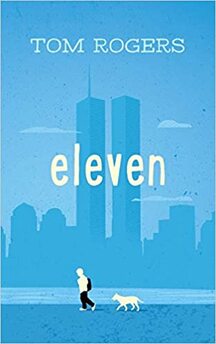
“Sometimes when a terrible thing happens, it can make a beautiful thing seem even more precious.”
Eleven is the story of Alex who is turning 11 on September 11, 2001. I was concerned that the character would be too young for this topic. I also thought that, the character age’s implied that the novel wouldn’t contain the complexity the topic deserves. but, boy, was I wrong! I was hooked with the complexity of the first 2-page chapter. I wasn’t sure what was happening in this introductory chapter, but it was not a feeling of confusion as much as “It could be this; no, it could be this…” and inference and interpretation, even visualization.
I also forgot that New York City kids grow up faster, taking public transportation throughout the city, but more importantly, I forgot that when you need or expect a young adolescent to rise to the occasion, he will.
Alex loves airplanes and dogs—and he doesn’t realize it, but he loves his little sister Nunu who is relegated to her side of the bedroom they share by a black and yellow “flight line” down the middle of the room. And he loves his father, even though Alex told him, “I hate you,” the night before 9/11. When the Towers fall, Alex rises to the occasion, taking care of his little sister and an abandoned dog, making the sacrifice to return the dog he has always wanted to his owners when the vet finds a chip, facing bullies, making “deals” in the hopes these deals and good works will offset what he said to his father and ascertain his return from the Towers, and comforting Mac, a lonely man who is awaiting his only son’s return from the Towers.
In Eleven author Tom Rogers builds a character who is authentic, a kid who events serve to turn into a young man. Alex’s mother had said to him, “I need you to be grown up today” and, even though he was focusing on his misdeeds of the day, he did. “I’m proud of you, young man…. Young Man. Alex liked how that sounded.”
Warning: Have a box of tissues handy. I was a puddle when I finished the novel. This book is not graphic but does not skirt the events. We hear the news announcement about the four airplanes and, more chilling, a description of an empty hospital—“There were no gurneys rolling through to the ER, no sick and wounded in pain. There wasn’t a patient in sight. And he knew then that none would be coming.” A powerful examination of the events of 9/11 and how they affected ordinary people—and one boy’s birthday.
Baskin, Nora Raleigh. Nine, Ten: A September 11 Story. Atheneum Books for Young Readers, 2016. (Middle Grades)
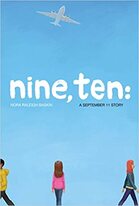
Nine Ten: A September 11 Story is another novel effective in introducing young adolescent students to the many events of September 11, 2001. Nora Raleigh Baskin’s novel is set during the days leading up to 9/11—in Brooklyn, Los Angeles, Columbus, and Shanksvlle, Pennsylvania, where readers follow four diverse middle-grade students affected by the events of 9/11. Sergio, Naheed, Aimee, and Will first cross paths in the O’Hare Airport on September 9. The four young adolescents are Black, White, Jewish, and Muslim and are collectively surviving loss, guilt, poverty, parental absence, neglectful fathers, bullying, the navigation of peer relationships, as well as the angst of middle school, “…everything felt different, as if you suddenly realized you had been coming to school in your pajamas and you had to figure out a way to hide this fact before anyone else noticed.” (p. 48). In their own ways they are each affected by 9/11, and on September 11, 2002, these four and their families again converge at Ground Zero, each there for different reasons, but this time their paths back together have meaning.
There are a multitude of important conversations to be generated by this little novel, a story of Before and After. I was especially grateful that the events and heroes of Shanksville were memorialized. In fact there are many aspects of heroism brought forth in the novel to discuss. But Nine, Ten: A September 11 Story is the story of people and three days in their lives, “Because in the end it was just about people…Because the world changed that day, slowly and then all at once.” (p. 176).
Rhodes, Jewell Parker. Towers Falling. Little, Brown and Company, 2016. (Middle Grades)
| I was a middle-school teacher in 2001. It was challenging to know how to discuss the events of 9/11 as we lived through them. How is a teacher to meaningfully discuss this momentous event with students who were not even born in 2001? Towers Falling is a thoughtful, provocative, well-written, albeit emotional, novel about this topic written sensitively and appropriately for readers as young as Grade 4, an ideal novel for middle grades Social Studies classes as it focuses on not only the history of 9/11 and its place in American history but the ever-widening circles of relationships among, and connections between, Americans beginning with families, friends, schools, communities, cities, states, countries. The 5th grade characters explore “What does it mean to be an American?” as well as why history is relevant, alive, and, especially, personal as three students—one Black, one White, one Muslim—explore the effects of the events of 9/11 on each of their families. Déja’s “journey of discovery” about the falling of the Towers helps her father work through his connection to the event and his resulting PTSD. |
Cerra, Kerry O’Malley. Just a Drop of Water. Sky Pony Press, 2016. (Middle Grades)
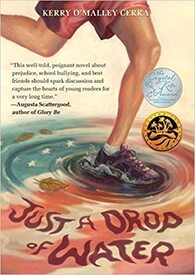
But then the events of September 11, 2001, occurred, and Martians did invade the earth, only they looked like Sam and his family—Muslim. Because one of the terrorists had lived in their neighborhood and was a client at the bank where Mr. Madina worked, Sam’s father comes under FBI surveillance, and the neighborhood divides in their support. Not Jake, though. He believes in his friend and his friend’s family, physically fighting the school bully who refers to Sam as a “towelhead” and arguing with his own mother whose own grief keeps her from supporting their neighbors.
When his father is taken into custody, Sam refuses to attend school, abandons his cross-country team, and distances himself from Jake, taking a new interest in the Islam religion. But Jake does not give up, and the boys reconnect to peacefully stop their racist classmates, Bobby and Rigo, from attacking the local mosque. Afterwards, Jake realizes that they both have been affected by 9/11; he has learned that you can be both scared and brave at the same time, but he has also has learned that adversity can be defeated peacefully. And Jake realizes that Sam is now different. “For the first time I see Sam, a Muslim. An American Muslim. But he is still just Sam, no matter what.”
Mills, Wendy. All We Have Left. Bloomsbury, 2016. (Young Adult)
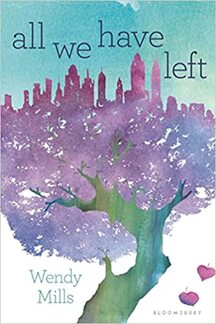
All We Have Left was so compelling that I read from dawn to dusk and did not put the book down until I finished. The novel intertwines two stories, that of 18-year-old Travis and sixteen-year-old Alia who were in the Towers as they fell and the story of Travis’ sister, Jesse, who, fifteen years later, is part of a dysfunctional family whose lives are still overwhelmingly affected by That Day and Travis’ death.
Seventeen year old Jesse is not sure who she is, who she should be, who she should hate, and who she can love. Her life is overshadowed by 9/11, her mother’s mourning, and her father’s hate.
But both Alia in 2001, and Jesse in 2016, learn that “Faith and strength aren’t something that you wear like some sort of costume; they come from inside you” (p.329) as does love. And Jesse realizes that she has to work on “treasuring right here, right now, because that’s important.” As one character says but all the characters learn, “You can fill that void inside you with anger, or you can fill it with the love for the ones who remain beside you, with hope for the future.”
What I appreciated about this novel is that is shows yet another side of how 9/11 affected people, especially adolescents, those adolescents who populate American schools everywhere. I strongly feel that students should not only be learning about the events and effects of 9/11, but that, through novels, readers learn more about how events affect people and especially children their ages.
Polisner, Gae. The Memory of Things. St. Martin’s Griffin, 2016. (Young Adult)
| The first 9/11 novel I read, The Memory of Things is lovely story about the effects of the events of 9/11. Another reason we read is to understand events we have not experienced and the effect of those events on others who may be like ourselves. After witnessing the fall of the first Twin Towers on 9-11 and evacuating his school, teenager Kyle Donahue, a student at Stuyvesant High School, discovers a girl who is covered in ash on the Brooklyn Bridge; she has no memory of who she is. The son of a detective, he takes her home to help her rediscover who she is, why she was where she was, what she was doing there, and her connection to the events. Author Gae Polisner wrote The Memory of Things in alternating narratives—Kyle's in prose, the girl writes in free verse—the two characters sharing their stories and perspectives, introducing adolescent readers, many of whom had were not alive during 9/11, to the effects of this tragedy in their own ways. |
Donwerth-Chikamatsu, Annie. Somewhere Among. Atheneum Books for Young Readers, 2016. (Middle Grades)
| Ema is binational, bicultural, bilingual, and biracial. Some people consider her “half,” and others consider her “double.” Her American mother says she contains “multitudes,” but Ema sometimes feels alone living in Japan somewhere among multitudes of people. When fifth-grader Ema and her mother go to live with Ema’s very traditional Japanese grandparents during a difficult pregnancy, author Annie Donwerth-Chikamatsu’s verse novel takes the reader through six months (June 21, 2001-January 2, 2002) of customs, rituals, and holidays, both Japanese and American. There are challenges, such a choosing a name for the new baby that brings good luck in Japan and that both sets of grandparents can pronounce. Ema celebrates American Independence Day and Japanese Sea Day, and she now views some days, such as August 15 Victory Over Japan Day from diverse perspectives. On September 11, 2001 Ema experiences both two typhoons in her town and the attacks on the World Trade Center and the Pentagon in America—on television. As the reader traverses the intricacies of two fusing two distinct cultures with Emi and her family, our knowledge of others is doubled. |
Stine, Catherine. Refugees. Delacorte Books for Young Readers, 2005. (Young Adult)
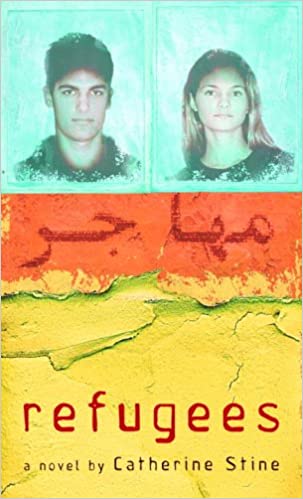
Dawn is a foster teen who runs away to New York City and becomes affected by the events of 9/11. As she plays her flute on the streets near Ground Zero to earn money for food, she is approached by families of victims who ask her to play for them and the memories of their loved ones. As Dawn comes to believe this is her mission, she teaches herself music she feels appropriate for those of many cultures and stages of life. In doing so, she opens up to strangers and new friends, something she couldn't do with her foster mother.
Johar is an Afghani teenager, weaver, and poet. His father is killed by the Taliban, his mother is killed by a land mine, his older brother joins the Taliban, and his aunt is missing, leaving Johar to care for his three-year-old cousin. He and his cousin flee to a refugee camp in Pakistan where he works for the Red Cross doctor, Dawn's foster mother, another person who must learn to show love.
Dawn and Johar connect through phone calls and emails, and as they all work toward forming a family—one that spans the globe—the reader learns how war, the U.S. involvement, and the events of 9/11 affected those in many countries. This would be a book I would recommend for proficient readers with an interest in war or history.
P.S. After I read this book and posted my original Goodreads review, I was listening to a discussion about the days following 9/11 in the Middle East on NPR and found that I could actually follow it; therefore, I realize that I learned more than I thought from this novel.
Maynard, Joyce. The Usual Rules. St. Martin’s Press, 2004. (Young Adult)
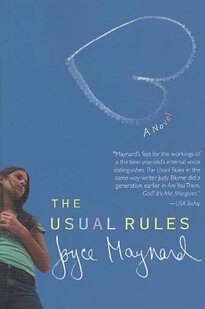
The reader learns about the close relationship between 13-year-old Wendy and her mother through flashbacks: her mother's divorce, the sporadic visits of her father, her mother's marriage to her "other dad," and the birth of her half-brother. And then her mother goes to work at her job at the World Trade Center on 9/11/2001—and does not return. Wendy’s world changes. “Then September happened and the planet she lived on had seemed more like a meteor, spinning and falling” (p. 175).
The reader experiences not only Wendy's (and Josh's and Louie's) loss but the suffering and uncertainty of those left behind. Could her mother be walking around, not remembering who she is? As the family hangs signs, we learn how different this loss was for many people who held out hope for a long time without a sense of closure. And this loss was different because it was experienced by many—an entire country in a way. “Instead of just dealing with your own heart getting ripped into pieces, wherever you looked you knew there were other people dealing with the same thing. You couldn’t even be alone with it” (p. 95).
We see the loss through the eyes and hearts of a daughter, a very young son, and a desperately-in-love husband. Wendy leaves Brooklyn and goes to her biological father’s in California. Among strangers, she re-invents her life. As those she meets help fill the hole in her life, she fills the hole in theirs. Books also help her to heal.
Even though there are quite a few characters in this novel, but they all are well-developed, and I found myself becoming involved in all their lives, not only Wendy, Josh, and Louie and even his father Garrett, but Wendy’s new friends—Carolyn, Alan, Todd, Violet… On some level they all have experienced trauma and loss, and within these relationships, Wendy is able to heal and return to rebuild her family.
Although I did not want this novel to end and to leave these characters, this well-written novel taught me more about the effects of September 11, loss, and the importance of relationships and added a new perspective to my collection of 9/11 novels.
Padian, Maria. Out of Nowhere. Knopf Books for Young Readers, 2013. (Young Adult)
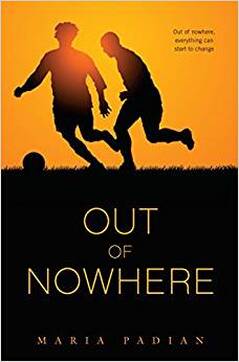
“Things get a little more complicated when you know somebody’s story.…It’s hard to fear someone, or be cruel to them, when you know their story.”
The majority of the 21.3 million refugees worldwide in 2016 were from Syria, Afghanistan and Somalia. The United States resettled 84,994 refugees. Together with immigrants, refugee children make up one in five children in the U.S. More than half the Syrian refugees who were resettled in the U.S. between October 2010 and November 2015 are under the age of 20.
.
In Out of Nowhere by Maria Padian, narrator Tom Bouchard is a high school senior. He is a soccer player, top of his class academically, and well-liked. He lives in Maine in a town that has become a secondary migration location for Somali refugees. These Somali students are trying to navigate high school without many benefits, including the English language. They face hostility from many of their fellow classmates and the townspeople, including the mayor; one teacher, at the request of students, permits only English to be spoken in her classroom. When four Somali boys join the soccer team, turning it into a winning team, and when he is forced to complete volunteer hours at the K Street Center where he tutors a young Somali boy and works with a female Somali classmate, Tom learns at least a part of their stories. Tom fights bigotry, especially that of his girlfriend—now ex-girlfriend, but he still doesn’t comprehend the complexity of the beliefs, customs, and traditions of his new friends, and his actions have negative consequences for all involved. While trying to defend the truth, Tom learns a valuable lesson, “Truth is a difficult word. One person’s truth is another person’s falsehood. People believe what appears to be true and what they feel is true.”
Lesson Learned: Tolerance and acceptance is not enough; we all need to reach respect (for others and their cultures, beliefs, and traditions).
Lowitz, Leza. Up from the Sea. Ember, 2016. (Middle Grades/Young Adult)
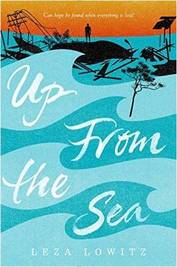
Instead of focusing on the overwhelming statistics generated by the March 11, 2011 earthquake and resulting tsunami in Japan—nearly 16,000 deaths and 3,000 people missing—the event becomes even more intense and compelling as author Leza Lowitz relates the story of one town and one boy and the resilience of many.
The story begins on March 11 when Kai, a half Japanese, half American 17-year-old and his teachers and classmates experience the “jolting of the earth,” and as trained, they evacuate, running for their lives, looking for the highest place, as their town is destroyed. Written powerfully in free verse, the reader feels the fury of nature as the water “churns,” “thrashes,” “surges,” “sweeps,” “charges.” Kai ends up in a shelter having lost his mother, his grandparents, and one of his best friends. His father left years before to return to America.
Faced with overwhelming loss and trauma, Kai walks into the ocean but is saved by one of his classmates and convinced to accept the opportunity to go to New York City on the tenth anniversary of 9/11 where he will spend some time with young adults who lost their parents as teens in the 9/11 attacks. At Ground Zero, Fia tells him, “Bravery means being scared and going forward anyway.”
Kai hopes to find his father in NYC but returns to his village to help the young adolescents who lost their families and to rebuild his town. “I want to be/ like that tree/ deep roots/ making it strong/ keeping it/ standing tall.” And it is to his roots Kai returns and stays—“The quake moved the earth/ ten inches/ on its axis./ I guess/I shifted,” too.”
Up from the Sea, well-written as a verse novel (a format that engages many reluctant readers), would serve as an effective continuation to a 9/11 study. Readers should already be aware of the events of 9/11 to understand the connection between Kai and Tom but will comprehend the trauma and loss experienced, and resilience that is required, by anyone who faces adversity.
Classes can read a variety of these novels to learn events from multiple perspectives—in small-group collaborative book clubs, generating provocative, important intra-group and inter-group conversations about the events of 9/11, intolerance, resilience, and relationships. Book Clubs can then share their novels, as well as creating an after-reading text synthesis for increased comprehension of the text(s) read, through presentations to the rest of the class. I have found “I Am’ poems of each of the characters to be particularly effective if students are required to first make a storyboard or summary of the novel events to establish that all key events are included somewhere in the groups’ poems. See #NineElevenNovelStudy for lesson ideas. Through these diverse novels, readers can experience the days before, the day of, the days after, the years following, and the many effects of the events of 9/11 on a variety of children, teens, and adults, these events and effects experienced from differing perspectives.

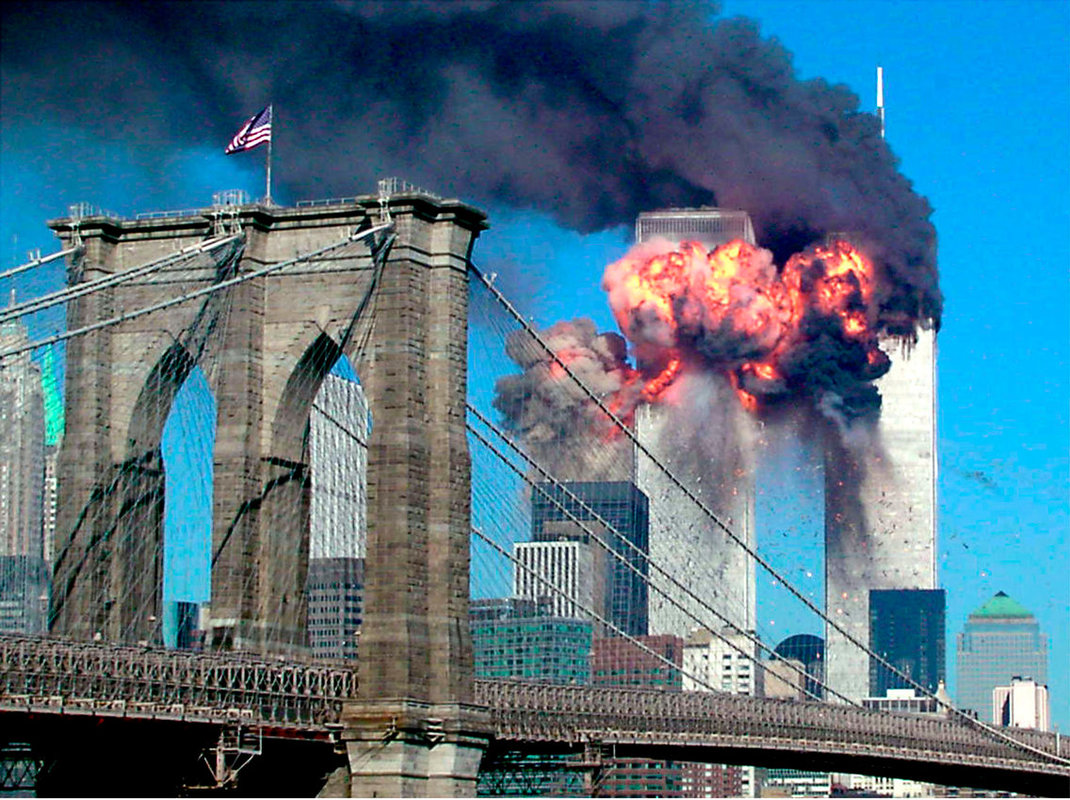
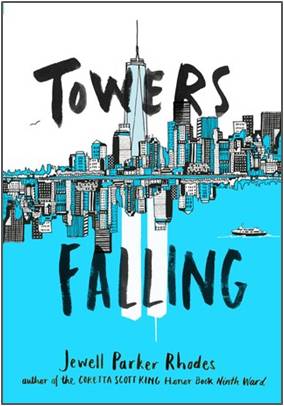
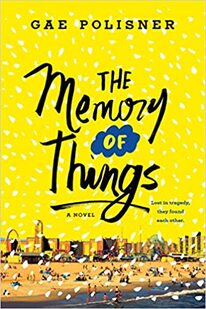


 RSS Feed
RSS Feed